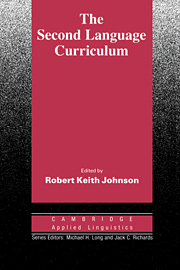Book contents
- Frontmatter
- Contents
- Contributors
- Series editors' preface
- Acknowledgements
- Overview
- I 1 CURRICULUM OVERVIEW
- I 2 CURRICULUM PLANNING
- II ENDS/MEANS SPECIFICATION
- III PROGRAMME IMPLEMENTATION
- IV CLASSROOM IMPLEMENTATION
- V EVALUATION
- Chapter 14 Language program evaluation: a synthesis of existing possibilities
- Chapter 15 The development and use of criterion-referenced tests of language ability in language program evaluation
- Chapter 16 Mastery decisions in program evaluation
- Chapter 17 Tailoring the evaluation to fit the context
- Bibliography
- Index
Chapter 15 - The development and use of criterion-referenced tests of language ability in language program evaluation
Published online by Cambridge University Press: 05 October 2012
- Frontmatter
- Contents
- Contributors
- Series editors' preface
- Acknowledgements
- Overview
- I 1 CURRICULUM OVERVIEW
- I 2 CURRICULUM PLANNING
- II ENDS/MEANS SPECIFICATION
- III PROGRAMME IMPLEMENTATION
- IV CLASSROOM IMPLEMENTATION
- V EVALUATION
- Chapter 14 Language program evaluation: a synthesis of existing possibilities
- Chapter 15 The development and use of criterion-referenced tests of language ability in language program evaluation
- Chapter 16 Mastery decisions in program evaluation
- Chapter 17 Tailoring the evaluation to fit the context
- Bibliography
- Index
Summary
Introduction
The role of measurement in program evaluation has become increasingly unclear in the past few years, and this is for several reasons. First, evaluators have come to recognize that the processes that take place in a language program are at least as important as the products of the program. That is, what happens in the classroom is of interest not only because of its relationship to program outcomes, but in its own right. Most of these processes, indeed those that are of greatest interest, that take place in the minds of learners, are extremely difficult to measure. A second reason for questioning the role of measurement in program evaluation is the emphasis that many current evaluation theories place on qualitative sources of information, in some cases to the virtual exclusion of quantitative data of any kind. And finally, there are the inadequacies of norm-referenced tests for the purposes of program evaluation and the negative repercussions of their continued use for these purposes.
But rather than causing us to abandon tests as part of language program evaluation, I believe these concerns must lead us to a reorientation in our thinking about the needs for tests and about the types of tests we need. The need to examine the processes of instruction and learning presents a different set of measurement problems from those encountered in measuring outcomes. For example, the use of communication strategies and the amount of comprehensible input a learner obtains are areas of considerable interest not only for second language acquisition research but, it would seem, for language program evaluation as well.
- Type
- Chapter
- Information
- The Second Language Curriculum , pp. 242 - 258Publisher: Cambridge University PressPrint publication year: 1989
- 12
- Cited by



